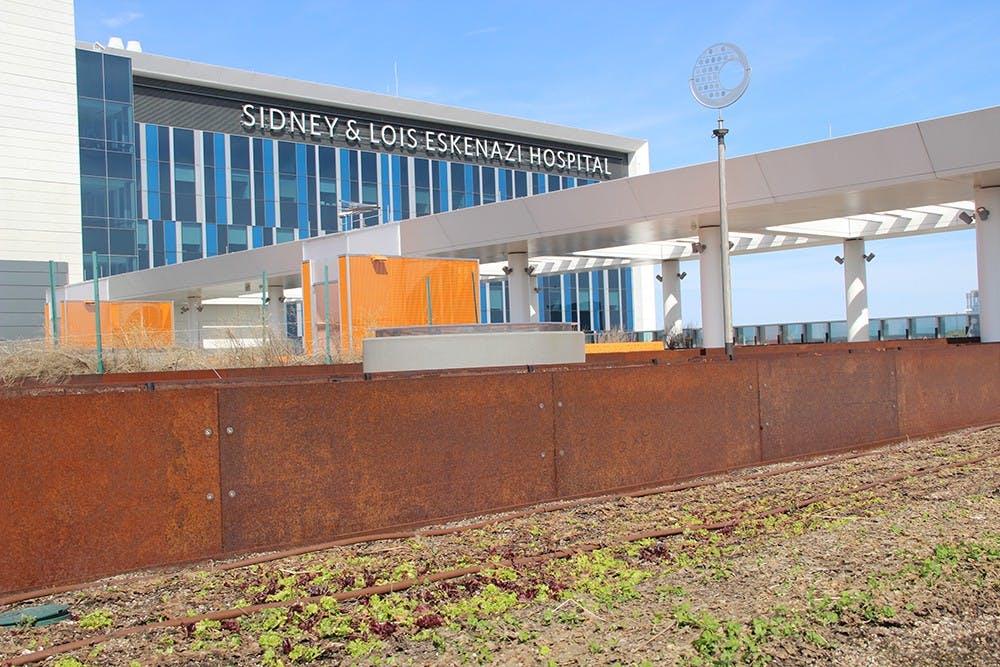Sidney Eskenazi grew up on the south side of Indianapolis during the Great Depression. His father died when he was 13 years old and, one week later, Eskenazi started his first job. Even during these hard times, he grew up watching his father, and later his uncle, donating food to charitable causes. This generosity inspired the young boy so that today he, along with his wife Lois, continue the trend of giving back, though on a much larger scale.
In 2011 the IU alumni, who met while attending college on the Bloomington campus, gave a $40 million donation to the Eskenazi Health Foundation, which financed the building of the brand new Sidney & Lois Eskenazi Hospital.
The public hospital campus was built as a replacement for the Wishard Memorial Hospital in downtown Indianapolis. It opened in December 2013 and today it is on track to becoming a Leadership in Energy and Environmental Design certified campus.
This certification, which is given by the United States Green Building Council, is reserved for buildings that have a positive influence on the health of their occupants while saving resources and promoting the use of clean energy and sustainable practices, according to the council’s website.
The certifications are classified as Bronze, Silver, Gold and Platinum. Should the campus attain a certification of Silver or higher, it would be the first ever hospital campus in the country to do so.
“There is a significant economic benefit to a LEED-certified building due to its decreased energy costs, but there are also measured improvements in employee retention and satisfaction, care and health outcomes and recovery time in LEED certified hospital settings,” Todd Harper, the media and public affairs manager for Eskenazi health, said.
Harper noted that studies have shown that being exposed to things like art and natural beauty is directly linked to an improved healing process for patients. Because of these findings, the hospital was built with large glass walls that let in a lot of natural light and provide views onto the hospital’s grounds.
“I really notice that they make an honest effort to be environmentally conscious here,” Brooke Arthur, a nurse at the hospital, said. “Everything is really nice and efficient. Compared to the other hospital I work at, it’s easy to see the difference.”
The eco-friendly design began with the way the
hospital was built. According to its website, 70 percent of the waste from construction ended up somewhere other than a landfill. Twenty-nine percent of the materials used to build the hospital had some recycled content and 25 percent of the materials came from local sources.
The hospital also reports a 40-percent decrease in potable water usage after minimizing unnecessary water use with things like automatic, low-flow faucets and waterless urinals. The building also brings in 100% fresh air, not recycling any air from within the building.
“The entire campus has been designed to meet the highest environmental standards, putting it at the forefront among new hospitals in energy efficiency, sustainability, green constriction and design,” Harper said.
One of the most visible signs of the foundation’s devotion to the environment is the Sky Farm, located on the hospital’s roof.
The 5,000-square foot area is used to grow more than 50 different types of plants, like blueberries,
tomatoes and asparagus, according to Rachel White, the woman in charge of the farm.
“It’s a place where patients and employees and community members can find some fresh air and a place where they can go to just relax,” White said. “The biggest role the farm plays at Eskenazi is educating people about food and how it effects your health.”
The garden is open to all of the campus staff and patients. The food grown on the Sky Farm is used in the cafeteria’s salad bar as well as cooking classes on campus around the city, according to White.
The hospital is also home to an environmentally-conscience restaurant and the Common Grounds, which is a green space where community members are welcome to enjoy the scenery and the outdoors.
“We’re creating spaces for everybody,” Harper said. “We want to be a destination so that you could come and tour the sky farm or look at the art or, if you’re a student, come and study even if you’re not visiting a patient.”
Food production is not the only way the hospital promotes sustainable eating habits. It also minimizes waste after meals have been eaten.
“We don’t just throw away food here,” Curtis Franklin, the team leader for one of the hospital’s food service areas, said. “People send their leftover food back into a kitchen and then I put it through the pulper, or that’s what we call it, to churn and grind it all up. It makes it much easier to biodegrade when we put it back into the soil.”
The hospital takes the 700 pound of waste generated daily from patient meals and feeds it into machines that first compost it and then dehydrate it to produce an odorless, easily biodegradable food waste.
“I also put the recyclable containers when I’m composting the food.” Franklin said. “We use these containers instead of styrofoam and that makes it even easier for the food to biodegrade when it gets back in the soil.”
Harper stressed that the patient’s health and saving lives is the number one priority for the hospital. The foundation’s achievements on environmental progress show that it is possible to take the environment into account in all aspects of society.






